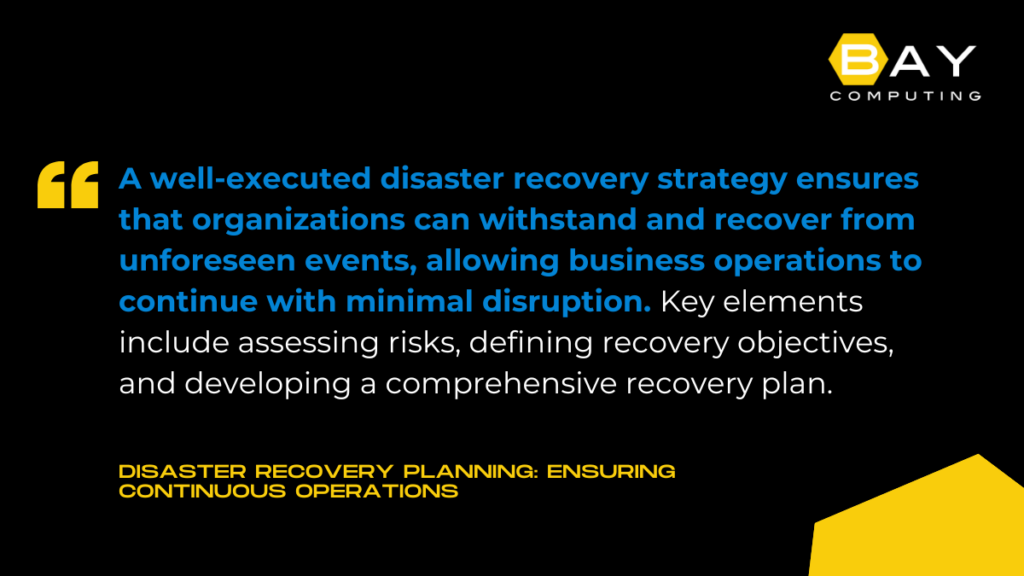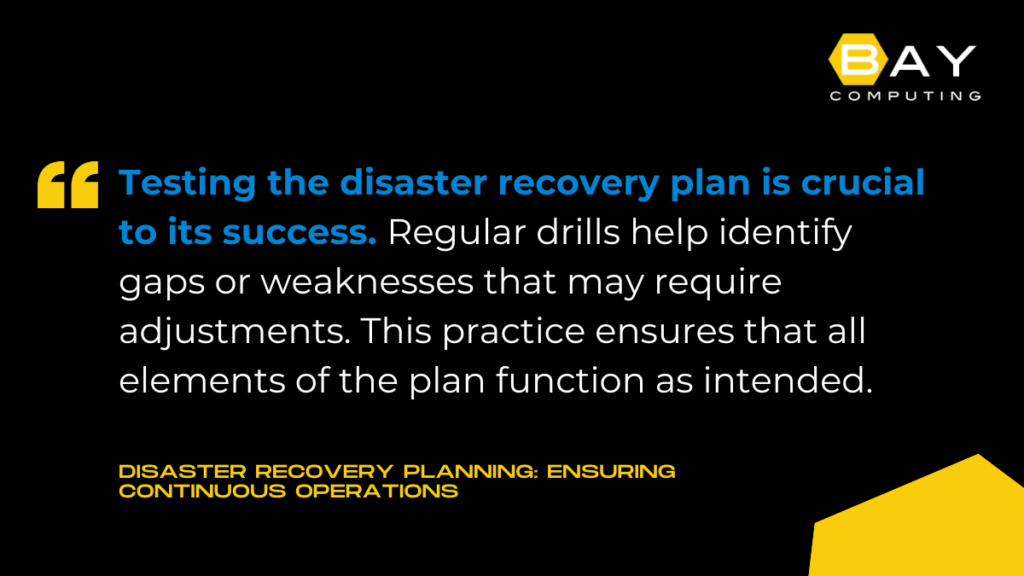Disaster Recovery Planning: Ensuring Continuous Operations
Preparing for disasters is not just an option—it’s a necessity for all businesses. Ensuring business continuity means having a solid disaster recovery planning that can keep operations running smoothly even in the face of unexpected events. Without it, a business may struggle to recover from disruptions that impact not only finances but reputation as well.
Disaster recovery planning involves making sure that critical data and processes are backed up and can be restored quickly. A well-crafted plan minimizes downtime and helps a business recover swiftly after a crisis. This kind of preparation is crucial for maintaining financial stability and operational efficiency during unexpected disruptions.
For any organization, understanding the difference between disaster recovery planning and a business continuity planning is key. While both plans work together to safeguard the company, they focus on different aspects of recovery. By integrating these plans effectively, businesses ensure they can handle challenges swiftly and maintain continuous operations.
Disaster Recovery Strategy

A well-executed disaster recovery strategy ensures that organizations can withstand and recover from unforeseen events, allowing business operations to continue with minimal disruption. Key elements include assessing risks, defining recovery objectives, and developing a comprehensive recovery plan.
Risk Assessment and Business Impact Analysis
Risk assessment is crucial in identifying potential threats to an organization’s operations. This process involves evaluating both natural and human-induced risks, such as floods, cyberattacks, or hardware failures. By understanding these risks, organizations can prioritize which areas require immediate attention.
Business impact analysis helps determine the effect of these risks on critical processes. It involves identifying key functions and estimating the financial and operational consequences of their disruption. This assessment is essential for gauging potential losses and ensuring the most vital parts of the business are safeguarded. This proactive approach enables organizations to allocate resources effectively and respond to emergencies promptly.
Defining Recovery Objectives
Defining clear recovery objectives is essential to guide the disaster recovery planning process. Organizations should set specific goals for recovery time objectives (RTO) and recovery point objectives (RPO). The RTO determines the maximum acceptable downtime for critical operations, while the RPO specifies the maximum data loss an organization can tolerate.
These objectives must align with the organization’s overall risk tolerance and recovery capabilities. Regularly reviewing and updating recovery objectives ensures they stay relevant to current business needs. Establishing these targets helps inform the disaster recovery plan and supports efficient resource allocation. Keeping goals realistic ensures that the organization can meet them under pressure.
Developing the Recovery Plan
Creating a detailed recovery plan is vital in laying the groundwork for effective disaster response. The plan should outline specific actions, assign roles, and establish communication protocols to ensure smooth execution during a crisis. Each team member’s responsibilities should be clearly defined to prevent confusion.
Regular testing and drills are necessary to evaluate the plan’s effectiveness. Conducting simulations helps identify potential gaps or weaknesses, offering opportunities for improvement before a real disaster occurs. Incorporating feedback and updates into the plan ensures it remains robust and adaptable. By rigorously developing and refining the recovery plan, organizations can mitigate risks and ensure a swift return to normal operations.
Implementation and Testing

Implementing and testing a disaster recovery plan is key to a company’s survival during unexpected events. This section covers the essential steps such as setting up a dedicated team, training staff, and regularly testing the plan to ensure readiness. It also emphasizes the importance of keeping the plan up to date with any changes in the organization.
Establishing a Disaster Recovery Team
Creating a strong disaster recovery team is the foundation of an effective plan. This team should include representatives from various departments, such as IT, operations, and human resources. Each member should have clear roles and responsibilities in order to act quickly when a disaster occurs.
Team members need to collaborate to identify potential risks and outline steps to respond to them. By understanding their roles, team members can efficiently work together to restore operations and minimize downtime.
Regular meetings should be held to discuss potential threats and update the plan. These meetings help the team stay informed and ready to respond to any incident. Selecting the right people for the team ensures that the company can efficiently handle any disruption.
Training and Awareness Programs
Training programs are vital for preparing staff to respond to disasters. Employees need to know their roles in emergency situations and how to execute specific tasks. Training sessions should be held regularly to reinforce knowledge and skills.
These programs can include hands-on exercises and workshops to simulate real-life scenarios. During these sessions, employees learn to handle stress and make informed decisions. Awareness programs should also provide information on the company’s recovery goals and how each employee contributes to achieving them.
By boosting awareness and ensuring everyone is familiar with the plan, employees become more confident in their ability to react swiftly to potential disruptions.
Regular Testing and Drills

Testing the disaster recovery plan is crucial to its success. Regular drills help identify gaps or weaknesses that may require adjustments. This practice ensures that all elements of the plan function as intended.
Scheduled drills keep team members alert and ready. These tests can vary from table-top exercises to full-scale simulations, each testing different parts of the plan. Evaluating these drills’ outcomes allows the team to improve processes and strengthen the plan.
Testing not only verifies that the recovery measures are effective, but also builds confidence among employees. With each test, the organization becomes better prepared for unexpected events, reducing response times and increasing resilience.
Maintaining and Updating the Plan
As companies evolve, their disaster recovery planning needs to adapt as well. Regularly reviewing and updating the plan ensures it remains in line with current business operations and technologies. Changes in the organization, such as new equipment or processes, must be accounted for in the plan.
Plan updates should also reflect changes in risk assessments and regulatory requirements. By incorporating feedback from past drills and real incidents, companies can make informed improvements.
Keeping the plan current helps maintain its relevance and reliability. Continuous updates and reviews ensure the organization can effectively handle disruptions, providing a roadmap to recovery when needed.
Protect Your Business Before Disaster Strikes
Ready to safeguard your business from unexpected disruptions? At Bay Computing, we specialize in IT services and building resilient disaster recovery solutions tailored to your organization’s specific needs. Don’t wait for a crisis to reveal weaknesses—take proactive steps now to ensure business continuity, minimize downtime, and protect your data and reputation.
Our expert team is here to help you create a future-proof recovery plan that keeps your operations running, no matter what challenges arise.
Contact Bay Computing today to schedule your free consultation.




